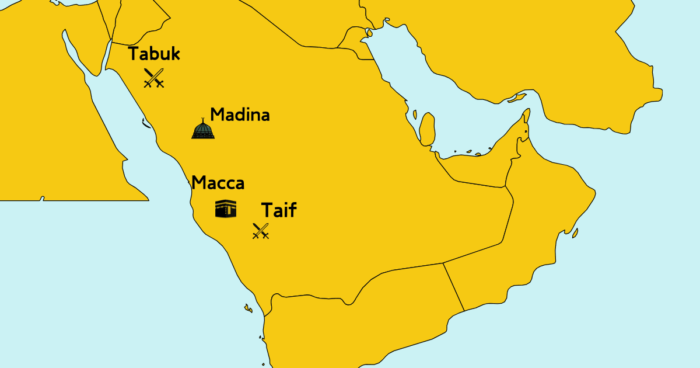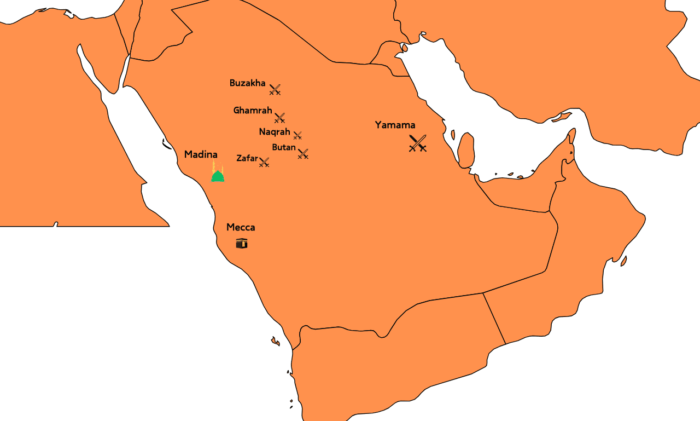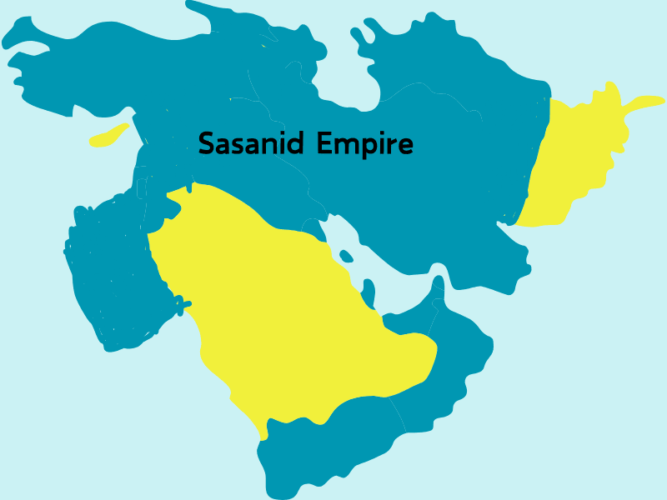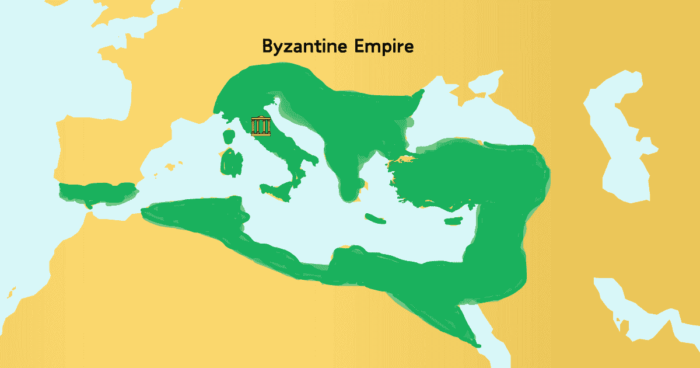The sword of Allah, Khalid bin Waleed, was a whirlwind of steel, leaving a trail of victory in his wake. – A.I. Akram
Khalid bin Waleed is celebrated for his extraordinary military achievements and strategic brilliance. His name is synonymous with victory and tactical innovation, leaving an indelible mark on early Islamic military history. Renowned for his unmatched leadership and tactical acumen, his campaigns played a part in the rapid expansion of the Rasidain Khaliphat.
This article delves into Khalid bin Waleed’s military campaigns and battles
Early Engagements and Conversion to Islam
The Pre-Islamic Period
Battle of Uhud (625 CE): Role Before Conversion
The Battle of Uhud was a critical confrontation between the early Muslims led by Prophet Muhammad and the Quraysh tribe led by Abu Sufyan ibn Harb, which took place in the year 625 CE. Khalid bin Waleed played a pivotal role in this battle, commanding the Quraysh cavalry with notable effectiveness. His tactical manoeuvring was useful in turning the tide against the Muslims during the battle.
Khalid’s strategic decisions during Uhud demonstrated his military acumen. He effectively exploited the weaknesses in the Muslim defences, particularly by attacking from the rear after initially engaging them head-on. This manoeuvre caused significant disruption among the Muslim forces, contributing to their eventual setback. Khalid’s actions in this battle showcased his strategic capabilities.
Post-Conversion: Early Battles
Battle of Mutah (629 CE): Khalid’s First Command
The Battle of Mutah, fought in 629 CE, was a significant early engagement for Khalid bin Waleed after his conversion to Islam. This battle was initiated as a response to the execution of a Muslim envoy by the Byzantine-affiliated Ghassanids. The Muslim force, led by three commanders—Zaid bin Haritha, Jafar ibn Abi Talib, and Abdullah bin Rawahah—was significantly outnumbered by the enemy.
During the battle, the Muslim commanders were killed, and Khalid, then a newly converted Muslim general, assumed command. Demonstrating exceptional tactical acumen, Khalid executed a strategic withdrawal to prevent a complete rout. His decision to retreat orderly rather than face annihilation was a remarkable demonstration of leadership and military strategy. This action not only saved the remaining Muslim forces but also earned Khalid the revered title of “Sword of Allah” (Saifullah) from Prophet Muhammad, recognising his valour and strategic skill.
Conquest of Mecca (630 CE): Role in the Conquest
Following the Battle of Mutah, Khalid bin Waleed participated in the peaceful Conquest of Mecca in 630 CE, marking a pivotal moment in Islamic history. Khalid bin Waleed played a crucial role in this momentous event. The Muslim forces, led by Prophet Muhammad, entered Mecca and secured the city with minimal conflict. While the conquest was largely peaceful due to the Prophet Muhammad’s strategy of forgiveness, Khalid’s contributions included managing the strategic movements of the Muslim army and securing the major entry points into the city, thus preventing any potential resistance and ensuring the smooth and peaceful transition of Mecca into the fold of Islam.
Campaigns in Arabia
After the conquest of Mecca, Khalid played an important role in consolidating Muslim control over the Arabian Peninsula. He led campaigns against tribes that resisted Islamic rule, including the Hawazin and Thaif tribes.
Battle of Hunayn (630 CE): Consolidation of Power
The Battle of Hunayn, fought in 630 CE, was a critical conflict that solidified Muslim control over the Arabian Peninsula.
Following the peaceful Conquest of Mecca, various tribes in the region were either aligning with the new Islamic state or resisting it. The Hawazin tribe, a formidable group with significant influence, opposed the new order, leading to a confrontation with the Muslim forces.
The initial stages saw the Muslim army ambushed by the Hawazin in a narrow valley, resulting in severe casualties and confusion. However, Khalid’s leadership and tactical expertise were crucial in reversing the situation. His command of the cavalry allowed him to move around the enemy forces, creating a counterattack that helped stabilise the Muslim position. Khalid’s effective response to the ambush and subsequent actions were pivotal in the victory at Hunayn.
Siege of Taif (630 CE): Military Tactics
After the Battle of Hunayn, the Prophet Muhammad ordered the siege of Taif, a fortified city that had resisted Muslim rule.
The Siege of Taif, also conducted in 630 CE, was part of the broader campaign to consolidate Muslim control in the region. Khalid bin Waleed played a crucial role in the siege, employing traditional military tactics such as the use of catapults and siege towers to encircle the city and exert pressure on its defenders.

Despite his effective tactics, the siege ultimately did not achieve its intended goal of conquering the city due to logistical challenges and the determined resistance of T’if’s defenders. Prophet Muhammad eventually ordered a withdrawal from the siege, acknowledging the difficulty of capturing the heavily fortified city. Khalid’s role in the blockade demonstrated his strategic flexibility and understanding of offensive and defensive warfare.
Battle of Tabuk (631 CE): Strategic Significance
The Battle of Tabuk fought in 631 CE, was an important expedition that underscored the strategic ambitions of the early Islamic state. Khalid bin Waleed was among the prominent commanders participating in this campaign. The expedition was launched in response to reports of the Byzantine invasion of the Arabian Peninsula. It was intended to assert Muslim influence and prevent any potential Byzantine aggression. While the actual confrontation with the Byzantine forces did not occur, the expedition successfully demonstrated the strength and reach of the Islamic state.

The campaigns in Arabia, including the pivotal Battle of Hunayn and the strategic Tabuk expedition, were helpful in consolidating and expanding the Islamic state’s influence. Khalid bin Waleed’s leadership and tactical skills played a crucial role in these successes, contributing to the stability and growth of the early Muslim empire.
Each of these early battles and campaigns highlighted Khalid bin Waleed’s evolution as a military leader and his significant contributions to the expansion and consolidation of the Islamic state.
The Ridda Wars (632–633 CE)

Now, Khalid bin al-Walid was the commander-in-chief of the subsequent battles.
After the Prophet Muhammad’s demise, the Arabian Peninsula witnessed a period of turmoil known as the Ridda Wars, or “Wars of Apostasy.” Several Arab tribes, taking advantage of the power vacuum, renounced Islam and challenged the authority of the newly established Caliphate. These wars were a series of military campaigns launched by Caliph Abu Bakr to bring back the tribes that had turned away from Islam. They were crucial for consolidating the nascent Islamic state and re-establishing its authority over the Arabian Peninsula.
Battle of Buzakha (632 CE): Subduing Apostate Tribes
One of the key battles in this campaign was the Battle of Buzakha, fought in 632 CE. This battle was a significant confrontation against the forces led by Tulayha al-Asadi, a self-proclaimed prophet (false Prophet) who had led a rebellion in central Arabia. Tulayha’s rebellion was part of a larger wave of apostasy and resistance that challenged the early Muslim state.
Caliph Abu Bakr appointed Khalid bin Waleed to lead the Muslim forces in this critical battle. Khalid’s forces successfully defeated Tulayha’s army, marking a turning point in the Ridda Wars. The victory at Buzakha effectively subdued the rebellion in central Arabia. It demonstrated Khalid’s ability to manage and lead military campaigns under challenging conditions.
Battle of Yamama (633 CE): Defeat of Musaylimah
The Battle of Yamama fought in 633 CE, was an intense conflict during the Ridda Wars, marking the end of the apostate rebellions and reaffirming the unity of the Arabian Peninsula under Islam. This battle was fought against the forces ofMusaylimah al-Kadhab (Musaylimah the Liar), a self-proclaimed prophet and leader of the Banu Hanifa tribe who had claimed prophecy in competition with Prophet Muhammad.
Khalid bin Waleed was given command of the Muslim forces for this critical battle. His leadership was important in defeating Musaylimah and Banu Hanifa. The fight was fiercely contested, with Musaylimah’s forces initially putting up a strong resistance. However, Khalid’s strategic brilliance turned the tide.
Khalid employed a series of tactical manoeuvres to overcome the enemy. He effectively used his cavalry to outflank and encircle the Banu Hanifa’s positions, breaking their lines and causing chaos within their ranks. The battle’s turning point came when Khalid’s forces pressed hard against the enemy’s positions, eventually leading to the death of Musaylimah himself. Musaylimah’s death was a decisive blow to the rebellion and significantly weakened the apostate forces.
The victory at Yamama was crucial for several reasons:
- End of Apostate Rebellions: The defeat of Musaylimah marked the end of significant resistance to the Caliphate, effectively quelling the last major challenge to the Islamic state in Arabia.
- Reunification of Arabia: The victory consolidated the Islamic state’s control over the Arabian Peninsula, reuniting it under the authority of Caliph Abu Bakr. This was essential for stabilizing the nascent Muslim state and preparing it for further expansion.
- Khalid’s Strategic Genius: Khalid bin Waleed’s role in this battle demonstrated his exceptional military skills and strategic acumen. His ability to manage a complex battlefield situation and deliver a decisive victory reinforced his reputation as one of Islam’s greatest military leaders.
Campaigns in Iraq and Persia
Now, the time came to turn attention to the outside territory of the Arabian peninsula, and the campaigns were started to conquer the Persian empire (Iran was called Persia in those days), also known as the Sasanian Empire.

Battle of Kazima (633 CE): First Clash with the Sasanids
Following the consolidation of power in Arabia, Khalid bin Waleed turned his attention to the formidable Sasanid Empire. The Battle of Kazima marked the initial confrontation between the Muslim and Persian forces.
In 633 CE, Khalid led a Muslim army into Persian territory, targeting the strategic city of Kazima. Despite being outnumbered, Khalid’s strategic brilliance and the courage of his troops led to a decisive Muslim victory. This triumph signalled the beginning of the Islamic conquest of the Persian empire.
Battle of Walaja (633 CE): Double Envelopment Tactic
The Battle of Walaja was a critical juncture in the Muslim-Persian conflict. Khalid faced a numerically superior Persian army led by the capable general Rustam Farrukhzad. Khalid employed a brilliant tactical manoeuvre known as the double envelopment to overcome this disadvantage. He inflicted a crushing defeat on the enemy by surrounding the Persian forces and attacking them from multiple directions. This victory established Khalid’s reputation as an unparalleled military tactician.
Battle of Ullais (633 CE): The River of Blood
The Battle of Ullais was a particularly fierce encounter. In the heat of battle, Khalid vowed to create a “river of blood” from the slain Persians. The battle was marked by intense fighting, and Khalid’s forces eventually overwhelmed the Persian defenders. A large number of captured enemy soldiers were slaughtered, fulfilling Khalid’s vow and sending a powerful message about the consequences of opposing the Muslim army.
While the historical accuracy of the “river of blood” account is debated, it underscores the brutality of the conflict and the relentless pursuit of victory by Khalid and his troops.
Capture of Hira (633 CE): Strategic Importance
The capture of Hira, a strategically important city in Iraq, marked a significant milestone in the Muslim conquest. Hira, a key city in southern Iraq, served as the administrative and cultural centre of the Sasanian province of Iraq. It was vital for controlling trade routes and communication between the Arabian Peninsula and Persia. Its fall dealt a severe blow to Persian prestige. It opened the way for further Muslim advances into the empire’s heartland.
Battle of Firaz (634 CE), the Last Campaign in Iraq
The Battle of Firaz was Khalid bin Waleed’s final major campaign in Iraq, fought against a coalition of Persian, Byzantine, and Christian Arab forces. The battle was useful in consolidating Muslim control over the region. Khalid’s victory at Firaz dealt a decisive blow to the combined forces. It ensured the stability of Islamic rule in Iraq.
Each of these battles illustrated Khalid bin Waleed’s exceptional strategic and tactical capabilities. His campaigns in Iraq and Persia expanded the Islamic state. They demonstrated his adaptability and leadership in complex and challenging environments.
Campaigns in Syria and the Byzantine Empire

Battle of Ajnadayn (634 CE): First Major Clash with Byzantines
The Battle of Ajnadayn marked the first major confrontation between the Rashidun Caliphate and the Byzantine Empire, also called the Eastern Roman Empire, occurring in 634 CE. Khalid bin Waleed, leading a Muslim army, faced a strong Byzantine force. The battle was fierce and prolonged, but Khalid’s strategic brilliance and the courage of his troops ultimately led to a decisive Muslim victory. This triumph opened the gates of the Muslim expansion into Syria and laid the foundation for the subsequent Muslim conquests in the region.
Battle of Fahl (634 CE): Consolidation in the Levant
Succeeding in the victory at Ajnadayn, Khalid bin Waleed secured control over southern Palestine. His next objective was to consolidate Muslim gains and expand their territory. The Battle of Fahl fought against a Byzantine army in 634 CE, resulted in another decisive Muslim victory. This triumph solidified Muslim control over the Jordan Valley, a strategically important region. It paved the way for the advance of Damascus.
Siege of Damascus (634 CE): Strategic Siege Warfare
Damascus, the capital of the Byzantine province of Syria, was a city of immense strategic importance. Khalid bin Waleed laid siege to the city in 634 CE, employing military tactics, including encircling the city and cutting off supplies and diplomatic manoeuvres. The siege was prolonged and arduous but eventually led to the city’s surrender. The capture of Damascus marked a significance in the conquest of Syria and dealt a heavy blow to Byzantine morale influence in the region.
Battle of Marj-ur-Rum (635 CE): Pursuit of Byzantine Forces
After the fall of Damascus, the Byzantine army, under the command of Emperor Heraclius, launched a counteroffensive. The two armies clashed at Marj-ur-Rum in 635 CE in what would be one of the most decisive battles of the Arab-Byzantine wars. Khalid bin Waleed, with his characteristic brilliance, devised a battle plan that exploited the weaknesses of the Byzantine army. The Muslim victory at Marj-ur-Rum shattered the Byzantine hopes of recovering Syria and solidified Muslim dominance in the region.
Battle of Yarmouk (636 CE): Turning Point in Islamic Conquests
The Battle of Yarmouk in 636 CE, often called the “Day of Decision,” was the completion of the Arab-Byzantine wars in Syria. The Byzantine Empire amassed a massive army to reclaim the lost territories. Khalid bin Waleed, despite being outnumbered, employed a brilliant strategy that divided the Byzantine army and exploited its vulnerabilities. The victory at Yarmouk was a major blow to the Byzantines, leading to the collapse of their presence in Syria and establishing a strong Muslim foothold in the region.
Impact on Islamic Expansion
The success at Yarmouk was important in the expansion of the Islamic state. It marked the end of Byzantine control in Syria and paved the way for further Muslim conquests. Khalid’s leadership and strategic insight were crucial in achieving this pivotal victory.
Khalid bin Waleed’s Later Campaigns and Dismissal
Battle of Hazir (637 CE): Final Campaigns in Syria
Even after the decisive victories at Yarmouk and other battles, Khalid bin Waleed continued to be at the forefront of the Muslim conquests.
The Battle of Hazir in 637 CE was one of Khalid bin Waleed’s last significant engagements in Syria. This battle fought against the remnants of Byzantine forces and local resistance, underscored Khalid’s continued military prowess even towards the end of his career.
This battle was pivotal in securing the remaining territories in Syria, ensuring that Muslim dominance was firmly established. Khalid’s leadership and tactical decisions during this campaign were crucial in fortifying the gains made in previous battles and maintaining stability in the region.
Dismissal by Caliph Umar (638 CE): Reasons and Impact
In 638 CE, Khalid bin Waleed was dismissed from his position as the supreme military commander by Caliph Umar ibn al-Khattab. This decision marked a significant shift in Khalid’s career and had notable implications for the Islamic State.
Despite his dismissal, Khalid bin Waleed’s legacy as one of Islam’s greatest military commanders remained intact. His strategic genius and contributions to the expansion of the Islamic state continued to be recognized and celebrated. The decisions made by Caliph Umar, while controversial, were aimed at maintaining the stability and unity of the Caliphate, reflecting the complexities of leadership and governance in the early Islamic period.
Conclusion
Khalid bin Waleed remains a celebrated figure not only in Islamic history but also in the broader context of military history. His achievements continue to inspire and influence military leaders and scholars worldwide, ensuring that his legacy is one of history’s great military commanders.
Some Frequently Asked Questions
What was the “River of Blood” at the Battle of Ullais?
The Battle of Ullais is remembered for Khalid’s vow to create a “river of blood” from the defeated Persian forces, underscoring the intensity and brutality of the conflict.
How did the capture of Hira impact the Muslim conquest of Persia?
The capture of Hira was strategically important, as it opened the path for further Muslim expansion into Persian territory and dealt a blow to Persian authority in the region.
What are some of the most famous battles led by Khalid bin Waleed?
Khalid bin Waleed led numerous famous battles, including The Battle of Buzakha, the Battle of Yamama, the Battle of Kazima, the Battle of Walaja, the Battle of Ullais, the Battle of Ajnadayn, the Battle of Marj-ur-Rum, and the Battle of Yarmouk.
References
Books:
- The Sword of Allah: Khalid bin Al-Waleed, His Life and Campaigns by Lieutenant-General A.I. Akram
- The Conquests of the Muslim World: An Analytical Study by Dr. M. A. Shaban.
- The History of the Islamic Empire: Military Campaigns and Strategies by Dr. M. H. Khan.
- The Sword of Allah: Khalid bin Al-Waleed
- Companions of the Prophet by Abdul Wahid Hamid
- The Armies of Islam, 7th-11th Centuries (1998) David Nicolle
- The Great Arab Conquests (1963) John Bagot Glubb
- In God’s Path: The Arab Conquests and the Creation of an Islamic Empire (2015) Robert G. Hoyland

1 thought on “Khalid bin Waleed’s Battles and Military Campaigns”